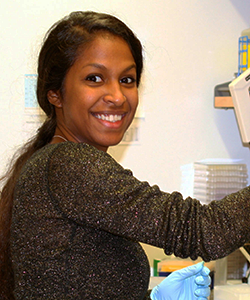
Salma Omer, Ph.D.
Department: Neuroscience, 2020
Faculty Mentor: Eric Delpire, Ph.D.
Dissertation Title: Characterizing Rare Disease-Causing Mutations in Genes Affecting Chloride Cotransport
Dissertation Abstract: Several human diseases have been associated with mutations in genes affecting cation-chloride cotransporters. My dissertation characterizes two single clinical cases with mutations in genes encoding protein kinase D1 (PKD1) and the Na-K-2Cl cotransporter-1 (NKCC1). The individual with a mutation in PKD1 (PKD1-Glu79X) suffers from peripheral neuropathy and epilepsy. When a catalytically inactive PKD1 kinase was expressed in Xenopus laevis oocytes, we observed increased K-Cl cotransporter 3 (KCC3) activity. Experiments performed on peripheral nerves extracted from a mouse model that recapitulates the patient mutation, established that complete loss of PKD1 function results in nerve pathology similar to the individual’s pathology with increased fiber diameter due to an increase in myelin thickness. Partial loss of PKD1 function did not result in a locomotor deficit. Pharmacological induction of seizures in PRKD1-E77X mice demonstrated an increase in seizure susceptibility compared with wild-type mice, consistent with the individual epileptic seizure activity. The patient with a mutation in NKCC1 (NKCC1-DFX) suffers from multi-organ failure and metabolic deficits. Using Fluorescent activated cell sorting of fibroblasts isolated from the NKCC1-DFX patient stained with a mitochondrial dye, I confirmed an increase in mitochondrial density compared to fibroblasts of healthy individuals. Furthermore, Seahorse metabolic assays demonstrated increased mitochondrial respiration in the patient NKCC1-DFX fibroblasts compared with control human fibroblasts. Madine Darby Canine Kidney (MDCK) cells transfected with NKCC1-DFX constructs also led to an increase in mitochondrial respiration compared with MDCK cells transfected with wild-type NKCC1. Using CRISPR/Cas9, we also generated a mouse model that recapitulated the NKCC1-DFX mutation and demonstrated that mouse fibroblasts expressing one or two copies of the mutant allele, also led to elevated mitochondrial respiration. NKCC1-DFX fibroblasts also demonstrated decreased expression of endoplasmic reticulum stress markers, in addition to elevated oxidative stress. These observations led us to conclude that the cells were behaving, like the patient cells, as they were in a state of starvation. In conclusion, generating mouse models expressing either the human PKD1 or NKCC1 mutations allowed for the in-depth study of their phenotypes and a better understanding of the human diseases associated with each of these mutations.